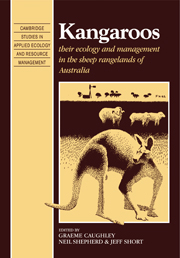Book contents
- Frontmatter
- Contents
- Preface
- Dedication
- THE STUDY AREA IN CONTEXT
- 1 Introduction to the sheep rangelands
- 2 The environment of the Australian sheep rangelands
- 3 The effect of weather on soil moisture and plant growth in the arid zone
- 4 Plant dynamics
- 5 The diet of herbivores in the sheep rangelands
- 6 Factors affecting food intake of rangelands herbivores
- 7 The mobility and habitat utilisation of kangaroos
- 8 Kangaroo dynamics
- 9 Condition and recruitment of kangaroos
- 10 Ecological relationships
- 11 Options for management of kangaroos
- Appendices to Chapter 8
- REFERENCES
- Author index
- Subject index
2 - The environment of the Australian sheep rangelands
Published online by Cambridge University Press: 05 November 2011
- Frontmatter
- Contents
- Preface
- Dedication
- THE STUDY AREA IN CONTEXT
- 1 Introduction to the sheep rangelands
- 2 The environment of the Australian sheep rangelands
- 3 The effect of weather on soil moisture and plant growth in the arid zone
- 4 Plant dynamics
- 5 The diet of herbivores in the sheep rangelands
- 6 Factors affecting food intake of rangelands herbivores
- 7 The mobility and habitat utilisation of kangaroos
- 8 Kangaroo dynamics
- 9 Condition and recruitment of kangaroos
- 10 Ecological relationships
- 11 Options for management of kangaroos
- Appendices to Chapter 8
- REFERENCES
- Author index
- Subject index
Summary
Introduction
The sheep rangelands, a subset of the arid and semi-arid lands of Australia, form a broad semi-circular arc from northern Queensland, through New South Wales, South Australia and the southern two-thirds of Western Australia (Fig. 1.5). It covers approximately 1.7 million km2 or 22% of the area of Australia. Climate determines the outer margin of the zone in the southern half of the continent: being the amount and incidence of rain sufficient to cultivate crops, particularly wheat. In southern New South Wales, South Australia and Western Australia this approximates the 260–290 mm isohyet. In southern Queensland the sheep rangelands extend into country receiving nearly 600 mm of rain per annum. The inner margin, where the sheep pastoral zone abuts either cattle rangelands or desert, is at about the 150 mm isohyet in the south and the 300 mm isohyet in the north.
This chapter examines the climate, soils, vegetation and fauna of the sheep rangelands of Australia, focusing on Kinchega National Park and a neighbouring sheep station, Tandou. These are located near the town of Menindee (elevation 61m) at approximately 32 degrees S and 142 degrees E in western New South Wales on the floodplain of the Darling River. Almost all data in succeeding chapters were collected on Kinchega and Tandou. Both were formerly part of a much larger pastoral lease and have been grazed by sheep since 1860. In 1967 Kinchega was declared a national park under the control of the New South Wales National Parks and Wildlife Service.
- Type
- Chapter
- Information
- KangaroosTheir Ecology and Management in the Sheep Rangelands of Australia, pp. 14 - 34Publisher: Cambridge University PressPrint publication year: 1987
- 11
- Cited by

